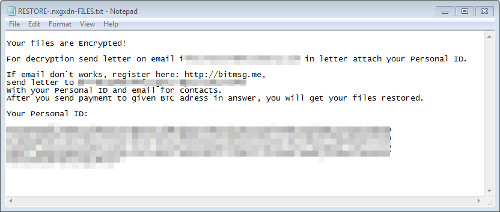RANSOM_RANSIX.A
Trojan-Ransom.Win32.Crypmodadv.xjw(Kaspersky);
Windows


Threat Type: Ransomware
Destructiveness: No
Encrypted: No
In the wild: Yes
OVERVIEW
This Ransomware arrives on a system as a file dropped by other malware or as a file downloaded unknowingly by users when visiting malicious sites.
It deletes itself after execution.
It drops files as ransom note.
TECHNICAL DETAILS
Arrival Details
This Ransomware arrives on a system as a file dropped by other malware or as a file downloaded unknowingly by users when visiting malicious sites.
Installation
This Ransomware drops the following files:
- %Application Data%\.{6 random letters}.log
(Note: %Application Data% is the Application Data folder, where it usually is C:\Documents and Settings\{user name}\Application Data on Windows 2000, Windows Server 2003, and Windows XP (32- and 64-bit); C:\Users\{user name}\AppData\Roaming on Windows Vista (32- and 64-bit), Windows 7 (32- and 64-bit), Windows 8 (32- and 64-bit), Windows 8.1 (32- and 64-bit), Windows Server 2008, and Windows Server 2012.)
Process Termination
This Ransomware terminates the following processes if found running in the affected system's memory:
- msftesql
- sqlagent
- sqlbrowser
- sqlservr
- sqlwriter
- oracle
- ocssd
- dbsnmp
- synctime
- mydesktopqos
- agntsvc
- isqlplussvc
- xfssvccon
- mydesktopservice
- ocautoupds
- agntsvc
- agntsvc
- agntsvc.exeencsvc
- firefoxconfig
- tbirdconfig
- ocomm
- mysqld
- mysqld-nt
- mysqld-opt
- dbeng50
- sqbcoreservice
Other Details
This Ransomware does the following:
- If the machine's locale is Russian, the malware terminates.
- Execute the following command to delete itself: cmd.exe /k ping 0 & del {malware file} & exit
It deletes itself after execution.
Ransomware Routine
This Ransomware avoids encrypting files with the following strings in their file name:
- .exe
- .sys
- .dll
- .ico
- .ovl
- .mui
- .ini
- .bif
- .swp
- .inf
- .scr
- manifest
- .link
- .tmp
- .temp
- ini
- .com
- .prx
- .bin
- .am
- .dlm
- .ngr
- .cur
- .idx
- .lnk
- .url
It avoids encrypting files found in the following folders:
- Program Files
- Program Files (x86)
- Windows
- Python26
- Python27
- Python34
- Python24
- AliWangWang
- Avira
- wamp
- Avira
- 360
- ATI
- Intel
- Internet Explorer
- Kaspersky Lab
- Microsoft Bing Pinyin
- Microsoft Chart Controls
- Microsoft Games
- Microsoft Office
- Microsoft.NET
- MicrosoftBAF
- MSBuild
- QQMailPlugin
- Realtek
- Skype
- Reference Assemblies
- Tencent
- USB Camera2
- WinRAR
- Windows Sidebar
- Windows Portable Devices
- Windows Photo Viewer
- Windows NT
- Windows Media Player
- Windows Mail
- NVIDIA Corporation
- Adobe
- IObit
- AVAST Software
- CCleaner
- AVG
- Mozilla Firefox
- VirtualDJ
- TeamViewer
- ICQ
- java
- Yahoo!
It renames encrypted files using the following names:
- {base64 values}
It appends the following extension to the file name of the encrypted files:
- .{6 random letters}
It drops the following file(s) as ransom note:
- {path to encrypted files}\RESTORE-.{6 random letters}-FILES.txt
It leaves text files that serve as ransom notes containing the following text:
SOLUTION
Step 1
Before doing any scans, Windows XP, Windows Vista, and Windows 7 users must disable System Restore to allow full scanning of their computers.
Step 2
Note that not all files, folders, and registry keys and entries are installed on your computer during this malware's/spyware's/grayware's execution. This may be due to incomplete installation or other operating system conditions. If you do not find the same files/folders/registry information, please proceed to the next step.
Step 3
Search and delete this file
- %Application Data%\.{6 random letters}.log
- {path to encrypted files}\RESTORE-.{6 random letters}-FILES.txt
Step 4
Scan your computer with your Trend Micro product to delete files detected as RANSOM_RANSIX.A. If the detected files have already been cleaned, deleted, or quarantined by your Trend Micro product, no further step is required. You may opt to simply delete the quarantined files. Please check this Knowledge Base page for more information.
Step 5
Restore encrypted files from backup.
Did this description help? Tell us how we did.


